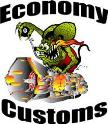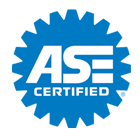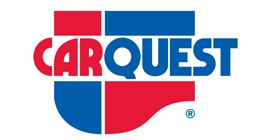Archive for July 2023Snake in the Engine (Serpentine Belt)Posted July 30, 2023 11:33 AMThere's a belt that snakes through your engine. It's even named for a snake, the serpentine belt. It'll bite you when it breaks, possibly leaving you stranded. So, it's good to know a little about this snake-like belt. In early engines, there were lots of belts. They were used to convert the rotating power of the engine to turn a mechanical part. But engineers had an idea. Why not consolidate all those belts into one that ran a bunch of different parts simultaneously? Voila! The serpentine belt. It's found in the front or side of your engine unlike older belts which were often in a V shape, the serpentine belt has ribs on it which more effectively connect with the pulleys that power the other components. A serpentine belt may power the water pump, power steering pump, alternator, and the air conditioning: all from one crankshaft. Now, all that's fine when everything is working well and the belt is intact. But when a serpentine belt wears, gets loose, or breaks, it can affect many engine components at once. Not an ideal situation. If you hear squeals coming from the engine compartment, see a battery light, or the engine overheats, those could be signs that your serpentine belt needs replacing. The good news is that they usually last a long time, from 60,000-100,000 miles or 100,000-160,000 km. Still, they don't last forever, and your vehicle's manufacturer usually recommends replacing them when they've gone close to the expected maximum. It’s also recommended that you replace the pulleys and belt tensioner at the same time as they have the same service life. Regular maintenance and inspection of the serpentine belt is not only a good idea; it’s one of those things that you should not let "slip" by. Economy Transmission and Auto Repair Giving CV Joints the Boot! (CV Joint and Boot Replacement)Posted July 23, 2023 11:34 AMEver wonder how your vehicle’s transmission is connected to your wheels? After all, when you hit a pothole or some other uneven part of a road’s surface, there has to be something that can maintain the connection between the transmission and the wheel yet keep everything moving at the same speed. That very cool device is called a CV joint, a kind of driveshaft running to each wheel. The CV stands for constant velocity because it keeps the drive wheels moving at a constant speed (velocity). They’re used mostly on front-wheel drive vehicles but also in rear-wheel and all-wheel drive vehicles. The joints move up and down and adjust to bumpy surfaces. Plus, they are covered in a rubber boot which protects them from road debris and also holds lubrication in. There’s a CV joint and boot on the transmission side and one on the wheel side. Unfortunately, the spot that usually fails first is that rubber protective cover (the boot). After a lot of wear, tear, bumps, road hazards, heat, and you name it, the rubber rips and the lubrication leaks out. At that point, it must be replaced. Here are signs to tell if your CV joint is bad.
Sometimes if a broken boot early is caught early, a technician can pack in new grease and replace just the boot. But if the lubrication has leaked out and the joint is already wearing badly, the CV and boot both have to be replaced. Give your vehicle the boot (as in a new boot) and CV joint, and you’ll be back on the road to your next destination. Economy Transmission and Auto Repair A Clean Start (Battery Cleaning)Posted July 16, 2023 10:12 AMYou may be fanatical about keeping the outside of your vehicle clean. But what about what's under the hood? Have you ever thought about how dirt and grime may be affecting your engine's components? One of the most important parts under your hood to keep clean is your vehicle's battery. With a daily barrage of dirt and moisture, outside parts of your battery can corrode, namely the cables and terminals. Gases vented by batteries can also promote corrosion. That can create connection problems and affect your vehicle's electrical system. If corrosion is not cleaned off, it may damage wires and terminals so badly that they will stop properly conducting electricity. At that point, they may need replacing. When you bring your vehicle to us for a battery inspection and cleaning, we will remove any corrosion and put corrosion-resistant protection on each post. A technician will also visually inspect your battery. Plus, we can test how much life is in your battery as part of a more comprehensive battery service. Batteries don't last forever and should be regularly cleaned, inspected, and tested. Usually, they'll need to be replaced anywhere from three to five years after they were first installed, but their lifespan depends on how, where, and how much you drive. Your battery is a very important component of your vehicle. Keep yours in tip-top shape, and it's less likely to let you down when you need it most. Economy Transmission and Auto Repair Differential ServicePosted July 9, 2023 8:44 AMWhen you're driving and turn a corner, you probably aren't aware of all that's going on with your wheels. The outside wheels have a longer distance to travel than the inside wheels, so there are gears that allow the wheels to go at different speeds when you turn. That set of gears is called a differential. In front-wheel drive vehicles, it's by the transmission and called a transaxle. Rear-wheel drive vehicles have the differential, naturally, on the rear axle. Many all-wheel and four-wheel drives add a center differential since power has to go to the front and rear wheels. (Some newer vehicles power wheels with electric motors, but that's a whole different story.) Time and distance traveled eventually can take their toll on the differential, and you may notice some noises you hadn't heard when your vehicle was newer. Sometimes you'll hear a whir that might change in pitch when you turn. You may hear clicking sounds when you're moving. Others describe rumbling sounds coming from underneath during a turn. Another symptom of possible differential problems may be vibrations or shakes the faster you go. All of these could be signs that you have problems with a differential. One common cause of differential problems is the gears aren't getting enough lubrication. These can all have serious effects on your driving. You may find it hard to turn, or your wheels may lock up. That could put you or drivers around you in a dangerous position. It's better to take care of differential problems before they get too serious. Bring in your vehicle so we can have a technician check yours out. They can see if there are any differential fluid leaks or failing gaskets. In some cases, we may recommend your differential fluid be replaced. And if there are any mechanical issues, some components may need to be replaced as well. When your differential is maintained, you'll be doing your vehicle a good turn. Economy Transmission and Auto Repair Read a Good Tire Lately? (Tire Wear)Posted July 2, 2023 7:30 AMThere's lots of good information to read in books and online. You might not know that you can also "read" your tires and learn a lot about what shape they're in and if they are in need of attention. It's important to know how your tires are doing because a tire failure can be very dangerous to you, your passengers and others on the road near you. You read your tire by looking at the surface that rides on the road, where the tread is. Check out the outer and inner edges. If you notice there's more wear on the inner or outer edge than on the rest of the tread, your vehicle could be out of alignment. Wear on an inner or outer edge could mean your wheels are leaning too much to one side. When you see this, visit our service center soon to have the alignment checked. What about if both edges are worn? That could be a sign that you don't have enough air in that tire. In an underinflated tire, the middle is not contacting the road surface as much as the edges, so the edges wear down first. It could also mean that you're taking corners too aggressively or your tires haven't been rotated on a regular schedule. Another thing you might see on your tires' tread area is wear in the center of the tire. That means you likely have too much air in that tire. Too much air makes your tire contact the road in the middle more than on the edges so the middle wears down prematurely. You might also see some smooth spots on the tread in irregular spots. This is called cupping. This is sometimes caused by suspension problems. A technician can examine your suspension to see if it is up to the manufacturer's specifications. Finally, you may spot tires that are worn unevenly in a pattern that goes diagonal to the tread pattern. This could mean your tires are out of balance, something our service center can check. They might also check alignment at the same time. Your tires are the only part of your vehicle that contacts the road surface. That means your acceleration, traction, steering and braking are all dependent on your tires being healthy. Maintain your tires by having one of our trained technicians read the clues and making sure they're always in roadworthy shape. Economy Transmission and Auto Repair | ||
SearchArchiveFebruary 2010 (2)March 2010 (4) April 2010 (3) May 2010 (4) June 2010 (4) July 2010 (4) August 2010 (4) September 2010 (5) October 2010 (1) November 2010 (5) December 2010 (5) January 2011 (4) February 2011 (4) March 2011 (5) April 2011 (4) May 2011 (4) June 2011 (5) July 2011 (4) August 2011 (21) September 2011 (4) October 2011 (4) November 2011 (5) December 2011 (4) January 2012 (5) February 2012 (4) March 2012 (4) April 2012 (4) May 2012 (2) June 2012 (3) July 2012 (1) August 2012 (1) November 2012 (1) December 2012 (2) March 2013 (1) April 2013 (3) May 2013 (2) October 2013 (5) November 2013 (2) January 2014 (2) February 2014 (3) March 2014 (2) July 2014 (3) August 2014 (7) September 2014 (4) October 2014 (5) November 2014 (4) December 2014 (4) January 2015 (5) February 2015 (4) March 2015 (4) April 2015 (5) May 2015 (2) June 2015 (6) July 2015 (2) September 2015 (2) October 2015 (5) November 2015 (3) December 2015 (3) February 2016 (1) March 2016 (5) April 2016 (4) May 2016 (5) June 2016 (4) July 2016 (5) August 2016 (4) September 2016 (4) October 2016 (5) November 2016 (4) December 2016 (4) January 2017 (5) February 2017 (4) March 2017 (4) April 2017 (4) May 2017 (4) June 2017 (5) July 2017 (5) August 2017 (4) September 2017 (3) October 2017 (5) November 2017 (4) December 2017 (3) January 2018 (5) February 2018 (4) March 2018 (4) April 2018 (5) May 2018 (4) June 2018 (4) July 2018 (5) August 2018 (4) September 2018 (5) October 2018 (4) November 2018 (4) December 2018 (5) January 2019 (4) March 2019 (4) May 2019 (2) June 2019 (5) July 2019 (2) August 2019 (2) September 2019 (4) October 2019 (5) November 2019 (4) December 2019 (5) January 2020 (5) February 2020 (4) March 2020 (5) April 2020 (1) May 2020 (2) July 2020 (2) August 2020 (5) September 2020 (4) October 2020 (4) November 2020 (5) December 2020 (4) January 2021 (6) February 2021 (4) March 2021 (4) April 2021 (4) May 2021 (5) June 2021 (4) July 2021 (4) August 2021 (5) September 2021 (4) October 2021 (5) November 2021 (4) December 2021 (4) January 2022 (6) February 2022 (4) March 2022 (4) April 2022 (4) May 2022 (5) June 2022 (4) July 2022 (3) September 2022 (4) October 2022 (5) November 2022 (4) December 2022 (4) January 2023 (5) February 2023 (4) March 2023 (4) April 2023 (5) May 2023 (4) June 2023 (4) July 2023 (5) August 2023 (4) September 2023 (4) October 2023 (1) January 2024 (1) February 2024 (4) March 2024 (1) | CategoriesTires and Wheels (40)Maintenance (53)Monitoring System (3)Fuel System (47)Older Vehicles (4)Drive Train (9)Steering (15)Warranty (2)Service Standards (13)Parts (7)Transmission (11)Trip Inspection (4)Service Intervals (9)Automotive News (8)Battery (20)Cabin Air Filter (8)Windshield Wipers (9)Brakes (22)Shocks & Struts (9)Cooling System (19)Timing Belt (6)Check Engine Light (6)Alignment (17)Fluids (17)Headlamps (6)Inspection (11)Exhaust (12)Differential Service (4)Air Conditioning (17)Safety (6)Dashboard (3)Diagnostics (5)Fuel Economy (10)Engine Air Filter (2)Suspension (3)Diesel Maintenance (1)Keys to a long lasting vehicle (4)Serpentine Belt (6)Alternator (6)Winter Prep (7)Emergency Items (1)Auto Safety (6)Fuel Saving Tip: Slow Down (2)What Customers Should Know (81)Tire Rotation and Balancing (3)Customer Detective Work (1)Oil Change (7)Wheel Bearings (1)Safe Driving (1)Tires (10)Water Pump (1)Winter Tires (1)Spark Plugs (2)TPMS (3)Brake Service (4)PCV Valve (2)Transfer Case Service (1)Fuel Pump (1)Shocks and Struts (1) | |








